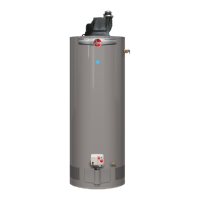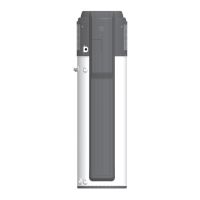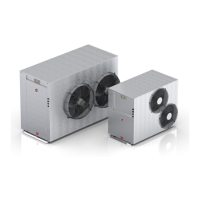11
WARNING: DO NOT attempt to convert this water heater for use with a different type of gas other than the
type shown on the rating plate. Such conversion could result in hazardous operating conditions.
High Altitude
This water heater is suitable and certified
for use at high altitude. Refer to the
altitude label on the water heater for
maximum allowable installation altitude.
WARNING: Installations above the
rated altitude as specified on the altitude
label are not authorized and may result in
improper and inefficient operation of the
appliance, producing carbon monoxide gas
in excess of acceptable limits, which could
result in serious injury or death.
Pressure Testing the Gas Supply System
The water heater and its manual gas
shut-off valve must be disconnected from
the gas supply piping system during any
pressure testing of that system at
pressures in excess of 3/8 psi (10.5” w.c.)
for natural gas, or 1/2 psi (14” w.c.) for
LP gas.
The water heater must be isolated from
the gas piping system by closing the
manual gas shut-off valve during any
pressure testing of the gas supply piping
at pressures equal to or less than
3/8 psi (10.5” w.c.) for natural gas, or
1/2 psi (14” w.c.) for LP gas.
Gas Supply
The branch gas supply line to the water
heater should be clean 1/2” black steel
pipe or other approved gas piping
material.
A ground joint union or ANSI design
certified semi-rigid or flexible gas
appliance connector should be installed
in the gas line close to the water heater.
The National Fuel Gas Code (NFGC)
mandates a manual gas shut-off valve: See
(NFGC) for complete instructions.
If flexible connectors are used, the
maximum length shall not exceed 36”.
Compound used on the threaded joints of
the gas piping must be of the type resistant
to the action of LP gas. Use compound
sparingly on male threads only.
Where a sediment trap is not incorporated
as part of the appliance, a sediment trap
shall be installed downstream of the
equipment shutoff valve as close to the
inlet of the appliance as practical at the
time of the appliance installation. The
sediment trap shall be either a tee fitting
with a capped nipple in the bottom outlet
or other device recognized as an effective
sediment trap. Do not use excessive force
(40 ft/lbs. Max Torque) in tightening the
pipe joint at the combination gas control
(thermostat) inlet, particularly if teflon
pipe compound is used, as the valve body
may be damaged.
The inlet gas pressure to the water heater
must not exceed 14” w.c. for natural gas,
or 14” w.c. for LP gas. For purposes of
input adjustment, the minimum inlet gas
pressure (with main burner on) is shown
on the water heater rating plate. If high or
low gas pressures are present, contact your
gas supplier for correction.
Leak Testing
The water heater and its gas connections
must be leak tested at normal operating
pressures before it is placed in operation.
Turn on the manual gas shut-off
valve near the water heater.
Use a soapy water solution to test for
leaks at all connections and fittings.
Bubbles indicate a gas leak that must
be corrected.
The factory connections to the
combination gas control (thermostat)
should also be leak tested after the water
heater is placed in operation.
WARNING: Never use
an open flame to test for
gas leaks, as property
damage, personal injury, or
death could result.

